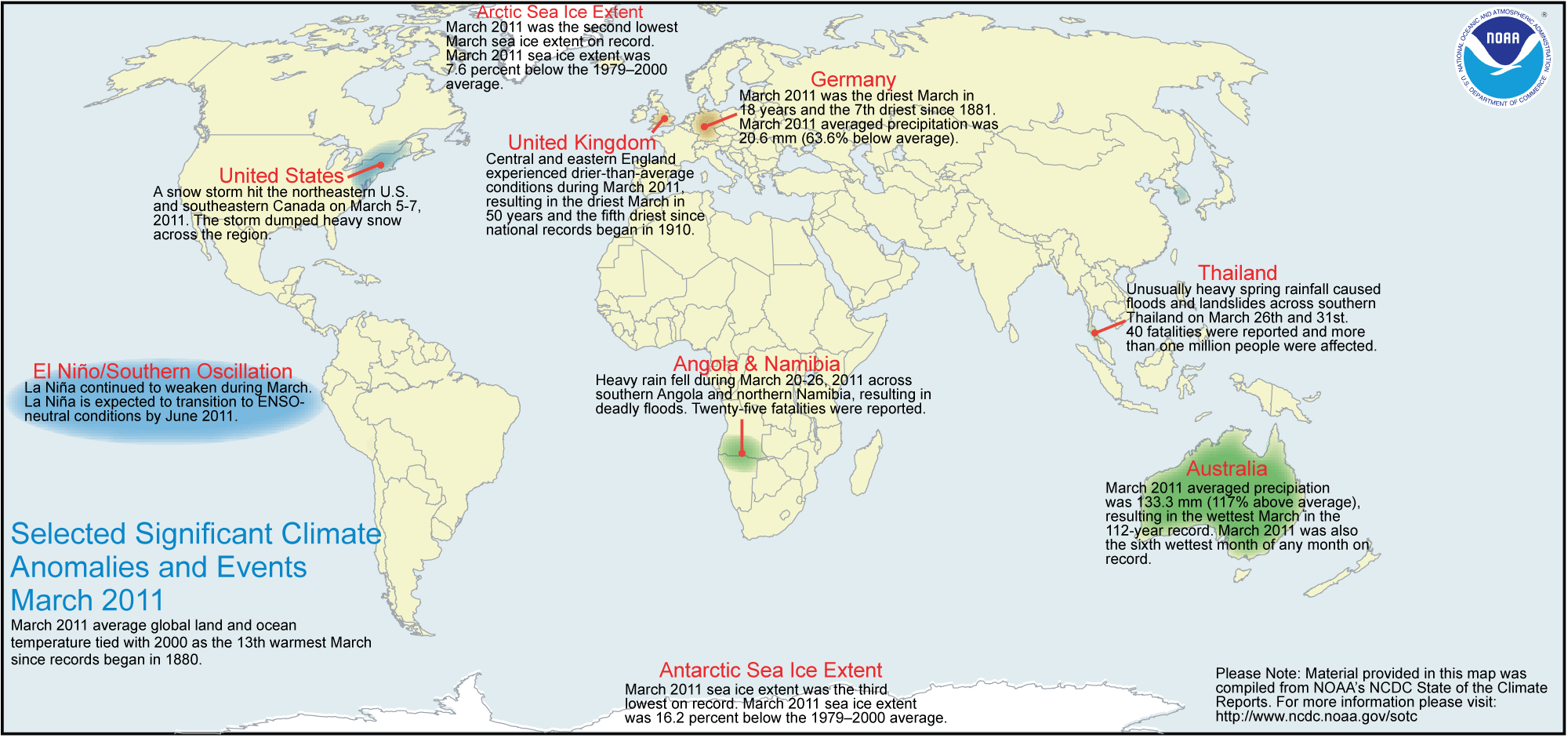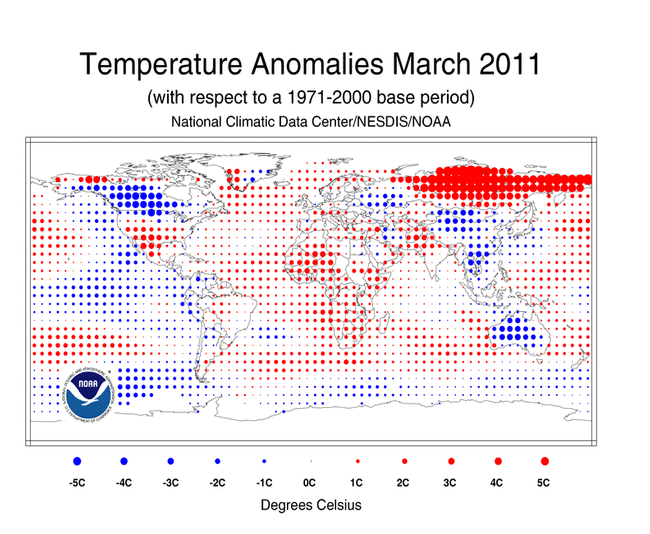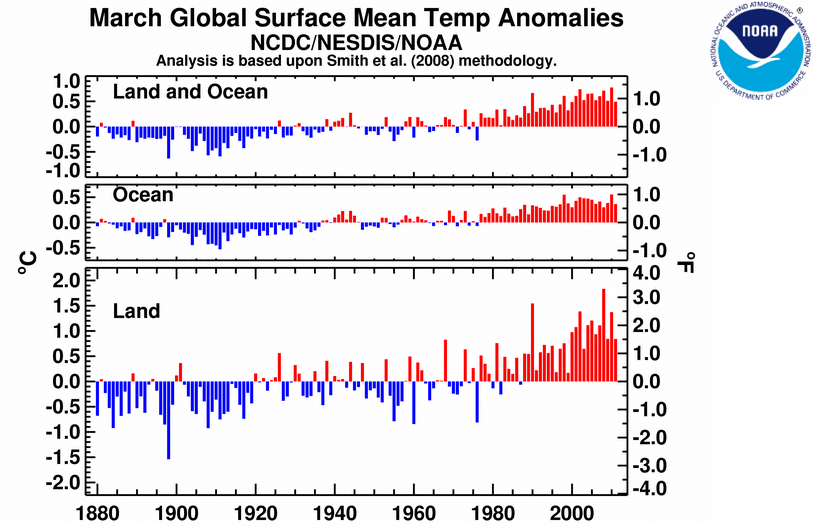Lead Image shows climate extremes for March 2011; NCDC Temperature and Precipitation Anomalies March 2011; Gallup Poll: Fewer Americans, Europeans View Global Warming as a Threat.
Global Highlights
- The combined global land and ocean average surface temperature for March 2011 was the 13th warmest on record at 13.19°C (55.78°F), which is 0.49°C (0.88°F) above the 20th century average of 12.7°C (54.9°F). This was also the 35th consecutive March with global land and ocean temperatures above the 20th century average.
- The March worldwide land surface temperature was 0.83°C (1.49°F) above the 20th century average of 5.0°C (40.8°F)—the 12th warmest March on record.
- The March worldwide ocean surface temperature was 0.36°C (0.65°F) above the 20th century average of 15.9°C (60.7°F)—also the 12th warmest March on record.
- For the year-to-date, the global combined land and ocean surface temperature of 12.73°C (54.87°F) was the 14th warmest January–March on record. This value is 0.43°C (0.77°F) above the 20th century average.
The combined global land and ocean surface temperature anomaly for March 2011 was 0.49°C (0.88°F) above the 20th century average, tying with 2000 as the 13th warmest March since records began in 1880. Sea surface temperatures (SST) during March 2011 were warmer than average across much of the world’s oceans, with cooler-than-average conditions across the central equatorial and eastern portions of the Pacific Ocean and the southern oceans. Warmer-than-average conditions were most pronounced in the equatorial Atlantic, the western Pacific oceans, and across the Southern Hemisphere midlatitudes. The March 2011 worldwide SST tied with 1997 as the 12th warmest on record, with an anomaly of 0.36°C (0.65°F) above the 20th century average. La Niña continued to weaken during March for the third consecutive month. According to NOAA’s Climate Prediction Center (CPC), La Niña is expected to transition to ENSO-neutral conditions by June 2011 but is also expected to continue to have global impacts through the Northern Hemisphere spring.
| January – March | Anomaly | Rank (out of 132 years) |
Warmest on Record | |||
|---|---|---|---|---|---|---|
| °C | °F | Year | °C | °F | ||
| Global | ||||||
| Land | +0.60 ± 0.23 | +1.08 ± 0.41 | 21st warmest* | 2002 | +1.42 | +2.56 |
| Ocean | +0.36 ± 0.04 | +0.65 ± 0.07 | 12th warmest | 1998 | +0.56 | +1.01 |
| Land and Ocean | +0.43 ± 0.09 | +0.77 ± 0.16 | 14th warmest* | 2002 | +0.72 | +1.30 |
| Northern Hemisphere | ||||||
| Land | +0.71 ± 0.27 | +1.28 ± 0.49 | 22nd warmest | 2002 | +1.80 | +3.24 |
| Ocean | +0.31 ± 0.05 | +0.56 ± 0.09 | 11th warmest | 1998 | +0.53 | +0.95 |
| Land and Ocean | +0.47 ± 0.14 | +0.85 ± 0.25 | 17th warmest* | 2002 | +0.94 | +1.69 |
| Southern Hemisphere | ||||||
| Land | +0.32 ± 0.12 | +0.58 ± 0.22 | 21st warmest | 2010 | +0.97 | +1.75 |
| Ocean | +0.41 ± 0.04 | +0.74 ± 0.07 | 13th warmest* | 1998 | +0.59 | +1.06 |
| Land and Ocean | +0.39 ± 0.07 | +0.70 ± 0.13 | 14th warmest* | 2010* | +0.63 | +1.13 |
*Signifies a tie
* Global Land tied with 1997 as 21st warmest on record.
* Global Land and Ocean tied with 2008 as 14th warmest on record.
* Northern Hemisphere Land and Ocean tied with 1997 as 17th warmest on record.
* Southern Hemisphere Ocean tied with 1999 as 13th warmest on record.
* Southern Hemisphere Land and Ocean tied with 1973 as 14th warmest on record. 1998 and 2010 tied as warmest on record.
Fewer Americans, Europeans View Global Warming as a Threat
Worldwide, 42% see serious risk, similar to 2007-2008
WASHINGTON, D.C. — Gallup surveys in 111 countries in 2010 find Americans and Europeans feeling substantially less threatened by climate change than they did a few years ago, while more Latin Americans and sub-Saharan Africans see themselves at risk.

The 42% of adults worldwide who see global warming as a threat to themselves and their families in 2010 hasn’t budged in the last few years, but increases and declines evident in some regions reflect the divisions on climate change between the developed and developing world.
Majorities in developed countries that are key participants in the global climate debate continue to view global warming as a serious threat, but their concern is more subdued than it was in 2007-2008. In the U.S., a slim majority (53%) currently see it as a serious personal threat, down from 63% in previous years.
Concern about global warming has also declined across western, southern, and eastern Europe, and in several cases, even more precipitously than in the U.S. In France, for example, the percentage saying global warming is a serious threat fell from 75% in 2007-2008 to 59% in 2010. In the United Kingdom, ground zero for the climate data-fixing scandal known as Climategate in 2009, the percentage dropped from 69% to 57% in the same period.




